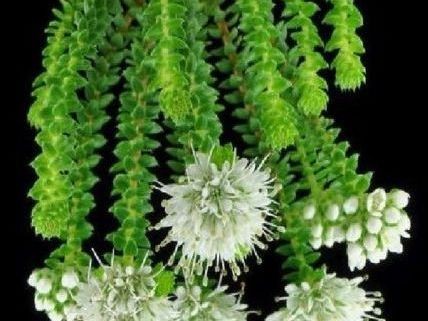Garlick Buchu
(Agathosma apiculata)

Description
Agathosma apiculata is a species of Magnoliopsida described by Ernst Meyer. Agathosma apiculata belongs to the genus Agathosma, and the family Rutaceae. Agathosma is a genus of about 140 species of flowering plants in the family Rutaceae, native to the southern part of Africa. Common names include Buchu, Boegoe, Bucco, Bookoo and Diosma. Buchu formally denotes two herbal species, prized for their fragrance and medicinal use despite their toxicity. In colloquial use however, the term (see Boegoe) is applied to a wider set of fragrant shrubs or substitutes. They are small shrubs and subshrubs, mostly with erect woody stems reaching 30–100 cm tall, but low-growing and prostrate in some species. The leaves are usually opposite, ericoid, often crowded, simple, entire, from 0.5-3.5 cm long. The flowers are produced in terminal clusters, 0.7–2 cm diameter, with five white, pink, red or purple, petals. Many of the species are highly aromatic, and the genus name means "good fragrance". Some species of the genus are used as herbal remedies. Two species of Agathosma endemic to the Western Cape mountains of South Africa and colloquially referred to as "Buchu" are cultivated on a commercial basis for their essential oils, Agathosma betulina and Agathosma crenulata. The leaves of Agathosma betulina have been used in traditional medicine. Bottled agathosma infusions were widely sold in English-speaking countries as "buchu tea" in the 1860s and 1870s. Although demand declined in the 1880s, consumption has continued to the present day; as of 2012, bottled infusions continue to be prepared from agathosma leaves. In addition, traditional buchu tinctures can be prepared by placing leaves and stalks into brandy. "Buchu vinegar", prepared by steeping the leaves and stalks in vinegar, also is a traditional remedy used for example in compresses and also taken internally. The essential oil is used in the manufacture of flavorings and perfume. There appear to be differences in people's perceptions of the smell, possibly determined genetically, rather than by familiarity or nurture. Some people find the smell to be repulsive, while most find it pleasantly herbal. This is not particularly unusual in reaction to the smells of many aromatic Karoo shrubs.
Taxonomic tree:







